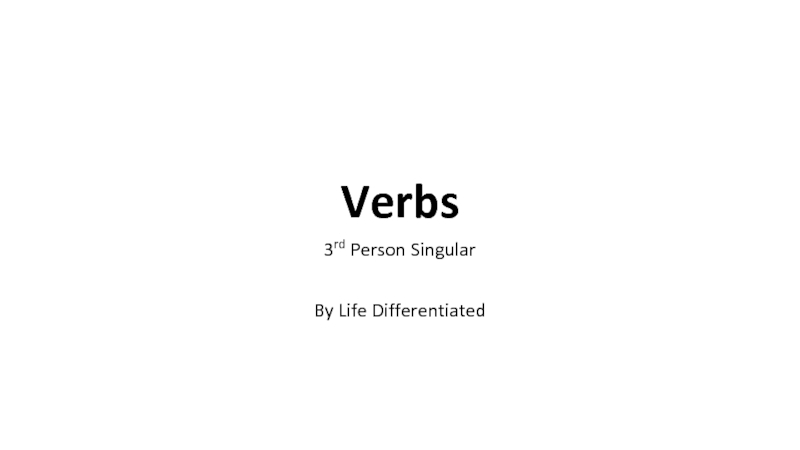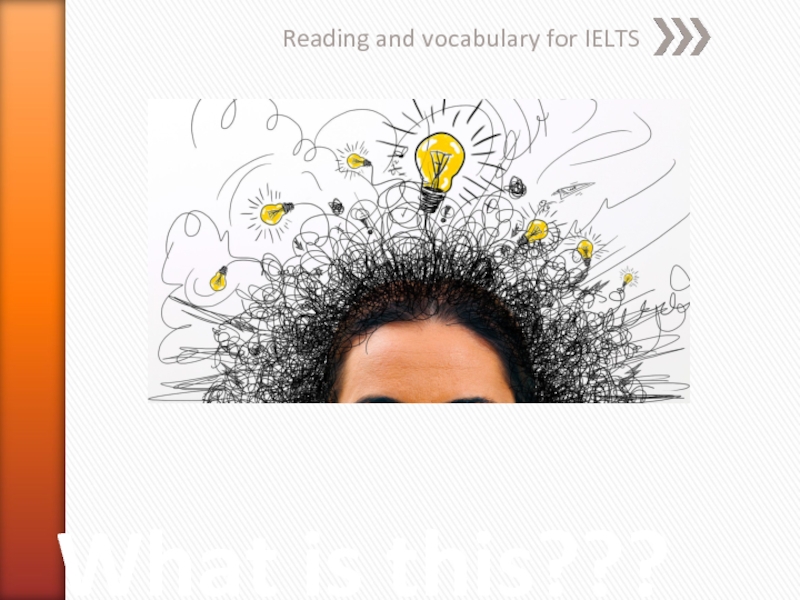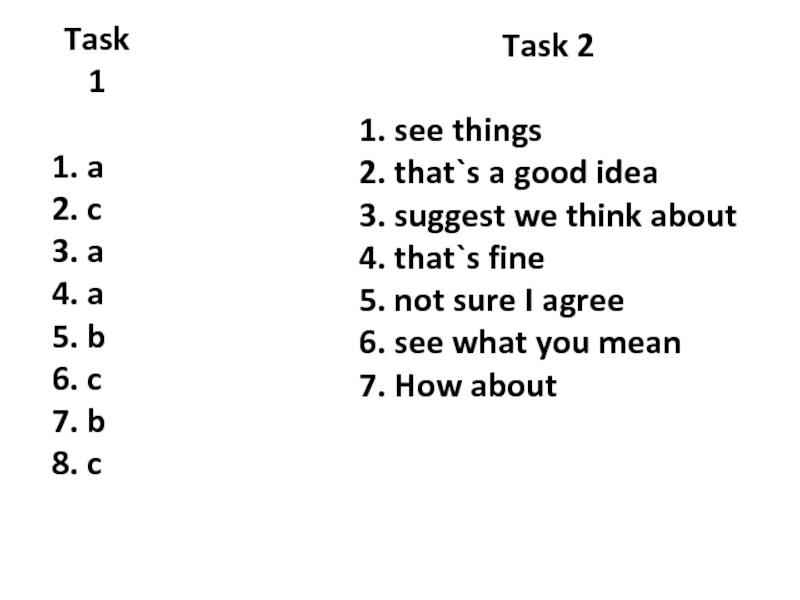basic notions of morphological analysis
2. Derivational structure of words & basic notions of derivational analysis.
- Главная
- Разное
- Дизайн
- Бизнес и предпринимательство
- Аналитика
- Образование
- Развлечения
- Красота и здоровье
- Финансы
- Государство
- Путешествия
- Спорт
- Недвижимость
- Армия
- Графика
- Культурология
- Еда и кулинария
- Лингвистика
- Английский язык
- Астрономия
- Алгебра
- Биология
- География
- Детские презентации
- Информатика
- История
- Литература
- Маркетинг
- Математика
- Медицина
- Менеджмент
- Музыка
- МХК
- Немецкий язык
- ОБЖ
- Обществознание
- Окружающий мир
- Педагогика
- Русский язык
- Технология
- Физика
- Философия
- Химия
- Шаблоны, картинки для презентаций
- Экология
- Экономика
- Юриспруденция
Structure of english words презентация
Содержание
- 1. Structure of english words
- 2. WORD STRUCTURE: approaches morphemic/morphological
- 3. MORPHEME – the smallest bilateral lg unit possessing both sound-form & mg.
- 4. MS lexical = derivation./word-building [do], [-ment],
- 5. Types of Morpheme Mg lexical
- 6. LEXICAL Mg of ms: transparent in
- 7. DIFFERENTIAL Mg of ms – semantic component
- 8. DISTRIBUTIONAL Mg of ms – the mg
- 9. Classification of ms semantic
- 10. Classification of ms
- 11. Bound roots of Greek/Latin origin: hyper(inflation), tele/pathy, mega(hit) combining forms/neoclassical compounds
- 12. Types of morph. segmentability words segmentable non-segmentable
- 13. COMPLETE type of segmentability: transparent
- 14. CONDITIONAL type of segmentability: segmentation
- 15. DEFECTIVE type of segmentability: constituent ms
- 16. Morphemic types of words WORDS monomorphic
- 17. PRINCIPLES of MORPHEMIC ANALYSIS Morph./morpholog. analysis
- 18. Procedure of morphemic analysis: defining
- 19. DERIV. STRUCTURE OF WORDS
- 20. Basic notions of deriv. analysis: deriv.
- 21. DERIV. BASE (DB) – a part of
- 22. Structurally DBs are: stems of various structure:
- 23. Deriv. affixes (DAs) form derivatives Deriv. pattern
- 24. DERIV. TYPES of words simple/simplexes/non-derived
- 25. DEGREE of derivation – the number of deriv. processes that took place in a word
- 26. unpredictable: un- +
- 27. aircraft-carrier: (n
- 28. denationalization: {de- +
Слайд 2WORD STRUCTURE: approaches
morphemic/morphological
analysis
derivational/word-formational analysis
morphem. structure
derivation. structure
number & type of morphemes (ms)
arrangement of ms to form words
Слайд 4MS
lexical =
derivation./word-building
[do], [-ment], [un-]
grammatical/functional = endings/inflections
[-s], [-ed], [-ing], [-er]
Слайд 5Types of Morpheme Mg
lexical
functional/ differential
part-of-speech
distributional
common to words too
specific to ms only
common to words too
specific to ms only
Слайд 6LEXICAL Mg of ms:
transparent in root-m.;
of generalizing character in
affixes (esp. endearing & diminutive sfxs: auntie, blankie; kitchenette; duckling, princeling)
FUNCTIONAL Mg of ms:
typical of affixes only: -ment, -er
FUNCTIONAL Mg of ms:
typical of affixes only: -ment, -er
Слайд 7DIFFERENTIAL Mg of ms – semantic component serving to distinguish one
word from all others containing identical morphemes
netbook, notebook
netbook, notebook
Слайд 8DISTRIBUTIONAL Mg of ms – the mg of the order &
arrangement of morphemes making up a word
driver -- *erdriv;
billboard – board bill
driver -- *erdriv;
billboard – board bill
Слайд 9Classification of ms
semantic structural
roots affixes
prefixes suffixes + infixes (statesman,
filmography)
Слайд 10Classification of ms
structural
free
bound semi-free/semi-bound
[run], [play]
[-hood], [un-], [re-]
[well] in well-known,
well-educated, well-bred, well-equipped, well-read
[proof] fire/water/sun/climate/weather/fool-proof
[run], [play]
[-hood], [un-], [re-]
[well] in well-known,
well-educated, well-bred, well-equipped, well-read
[proof] fire/water/sun/climate/weather/fool-proof
Слайд 11Bound roots of Greek/Latin origin:
hyper(inflation), tele/pathy, mega(hit)
combining forms/neoclassical compounds
Слайд 12Types of morph. segmentability
words
segmentable non-segmentable
root-words (run, go)
types
of segmentability
complete conditional defective
complete conditional defective
Слайд 13COMPLETE type of segmentability:
transparent morph. structure;
constituent ms recur with
the same mg in other words.
Слайд 14CONDITIONAL type of segmentability:
segmentation is possible for structural reasons
but is doubtful for semantic reasons
retain, contain, detain;
receive, deceive, conceive
pseudo-morphemes/quasi-morphemes
retain, contain, detain;
receive, deceive, conceive
pseudo-morphemes/quasi-morphemes
Слайд 15DEFECTIVE type of segmentability:
constituent ms seldom/never recur in other words
hamlet
(leaflet, crosslet, ringlet);
cranberry (gooseberry, strawberry)
unique morphemes
cranberry (gooseberry, strawberry)
unique morphemes
Слайд 16Morphemic types of words
WORDS
monomorphic polymorphic
root-words
monoradical polyradical
(safety-pin, flash mob)
radical-suffixal radical-prefixal (unfriend)
(blogger)
prefixal-radical-suffixal
(misinterpretation)
radical-suffixal radical-prefixal (unfriend)
(blogger)
prefixal-radical-suffixal
(misinterpretation)
Слайд 17PRINCIPLES of MORPHEMIC ANALYSIS
Morph./morpholog. analysis -- the division of a word
into its ultimate constituents, i.e. into constituent ms.
Слайд 18
Procedure of morphemic analysis: defining
if the word is segmentable/non-segmentable;
type of
segmentability (complete, conditional, defective);
number of ms;
semantic classification of ms;
structural classification of ms;
type of word according to its morph. structure
number of ms;
semantic classification of ms;
structural classification of ms;
type of word according to its morph. structure
Слайд 19
DERIV. STRUCTURE OF WORDS
DERIV. ANALYSIS studies the sequence of ms
& their successive joining in a word
binary principle of deriv. analysis: we break the word into 2 parts only
derivative = a word formed from a simpler lexical unit, that motivates it structurally & semantically
binary principle of deriv. analysis: we break the word into 2 parts only
derivative = a word formed from a simpler lexical unit, that motivates it structurally & semantically
Слайд 20Basic notions of deriv. analysis:
deriv. base (types)
deriv. affix(es)
deriv. pattern
type of word
according to its deriv. structure
degree of derivation
degree of derivation
Слайд 21DERIV. BASE (DB) – a part of a word to which
a rule of word-formation is applied (a part of a word from which the given word is built)
Слайд 22Structurally DBs are:
stems of various structure:
simple (girlish)
derived (girlishness)
compound (ex-girlfriend)
2) word-form
(unknown, smilingly)
3) word-group (blue-eyed, short-lived, do-gooder)
3) word-group (blue-eyed, short-lived, do-gooder)
Слайд 23Deriv. affixes (DAs) form derivatives
Deriv. pattern – a meaningful arrangement of
DB & DA: a model illustrating the way of creating a word
spoiler: V + -er N or V + sfx N
blissfully: Adj + -ly Adv or (N + -ful) + -ly Adv
spoiler: V + -er N or V + sfx N
blissfully: Adj + -ly Adv or (N + -ful) + -ly Adv
Слайд 24DERIV. TYPES of words
simple/simplexes/non-derived
derived words/complexes
derivatives
compound words
affix. derivatives 1) compound proper
conversion derivatives 2) deriv. compound
insider, to friend, straightjacket, suicide-bomber, honeymooner
affix. derivatives 1) compound proper
conversion derivatives 2) deriv. compound
insider, to friend, straightjacket, suicide-bomber, honeymooner
Слайд 28
denationalization:
{de- + [(n + -al) + -ize]} + -tion
N
a suffixational derivative of the 4th degree
a suffixational derivative of the 4th degree
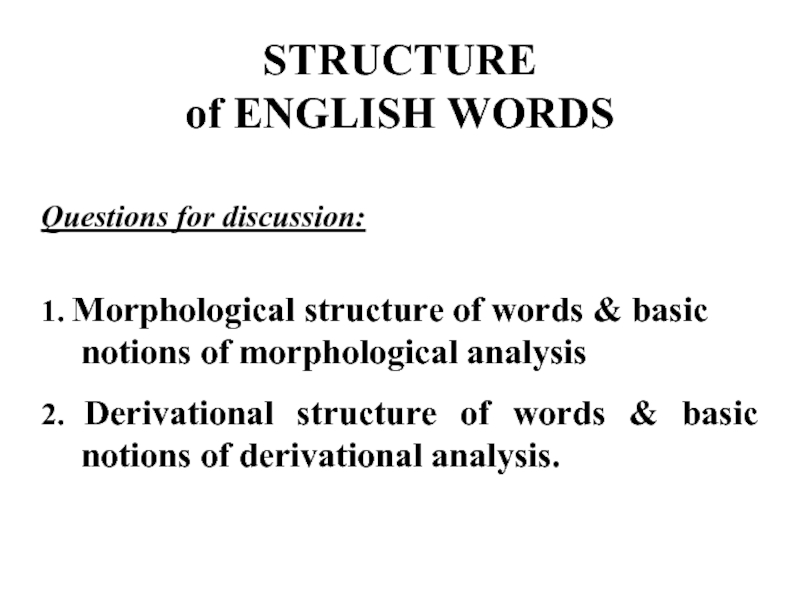
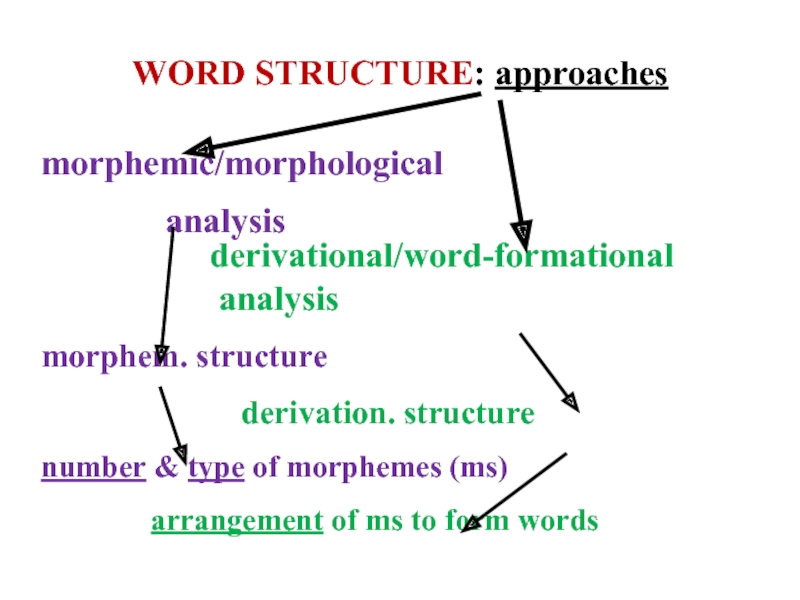
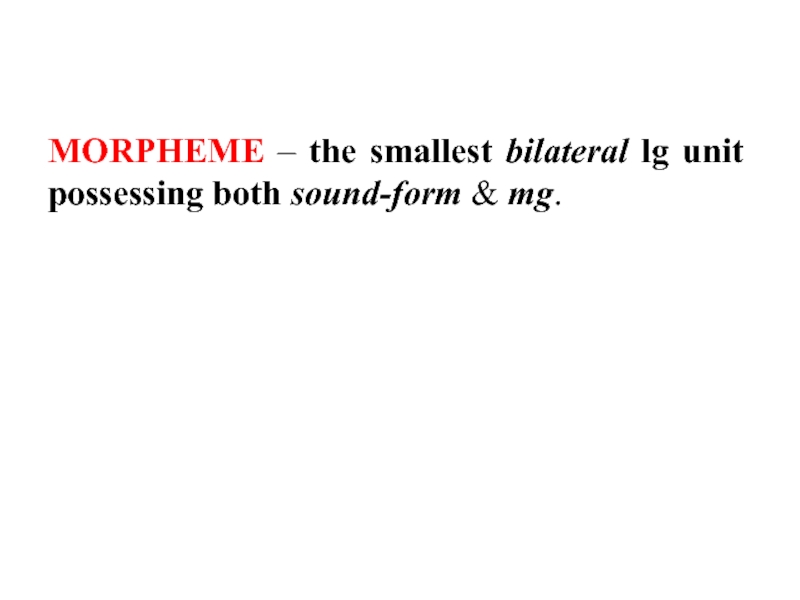
![MS lexical = derivation./word-building [do], [-ment], [un-] grammatical/functional = endings/inflections [-s], [-ed], [-ing], [-er]](/img/tmb/1/49428/57451106343852111549024ef18d3abf-800x.jpg)
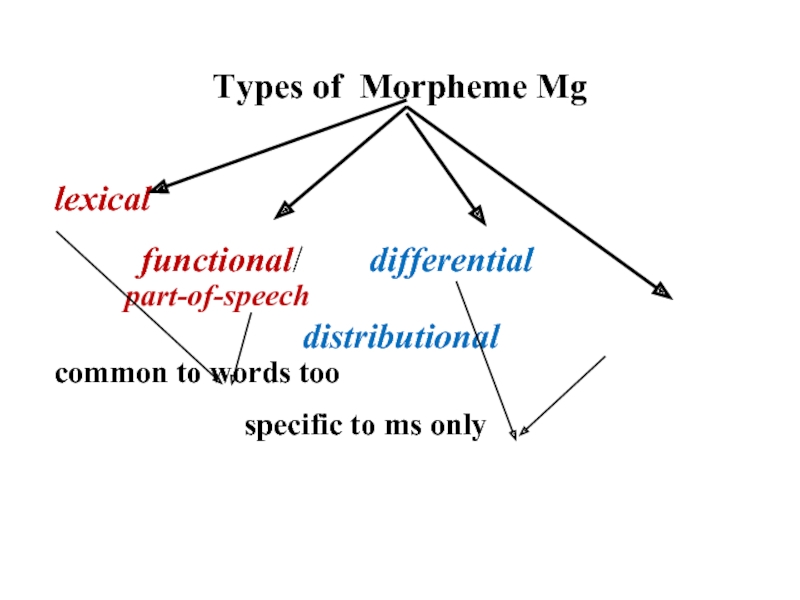
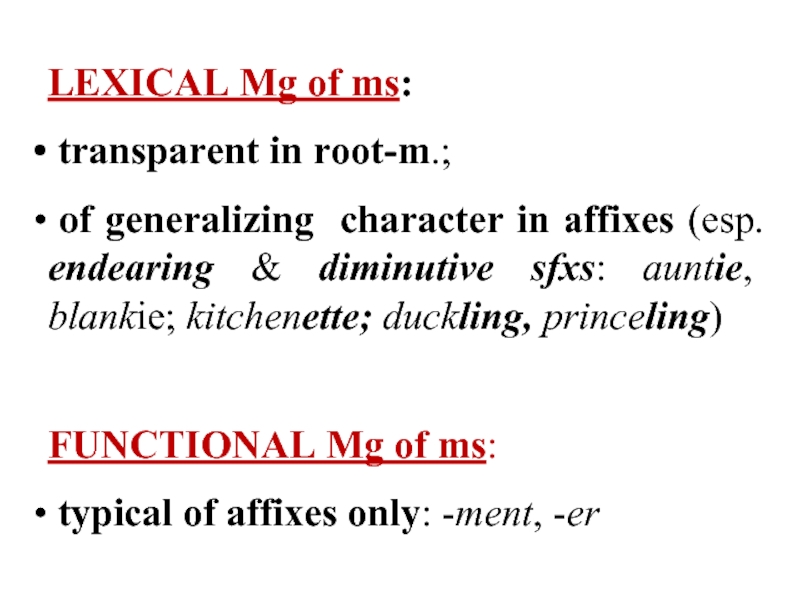
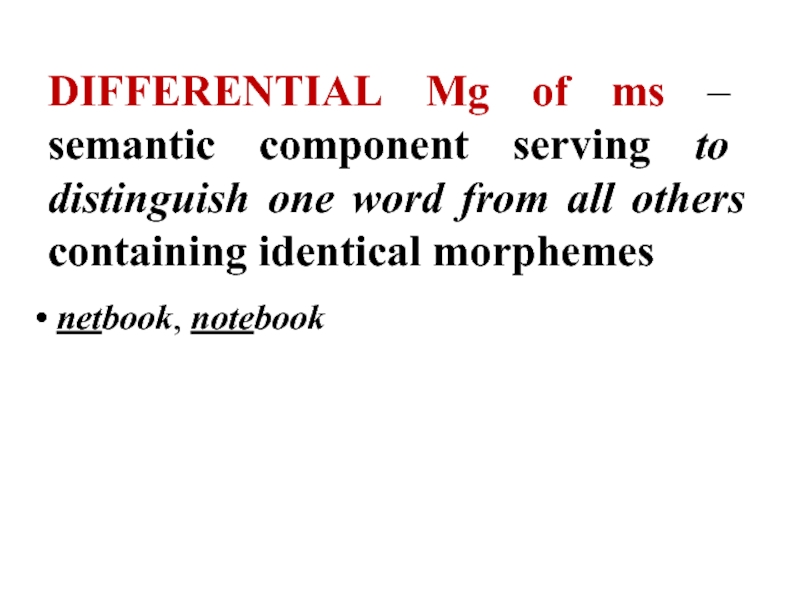
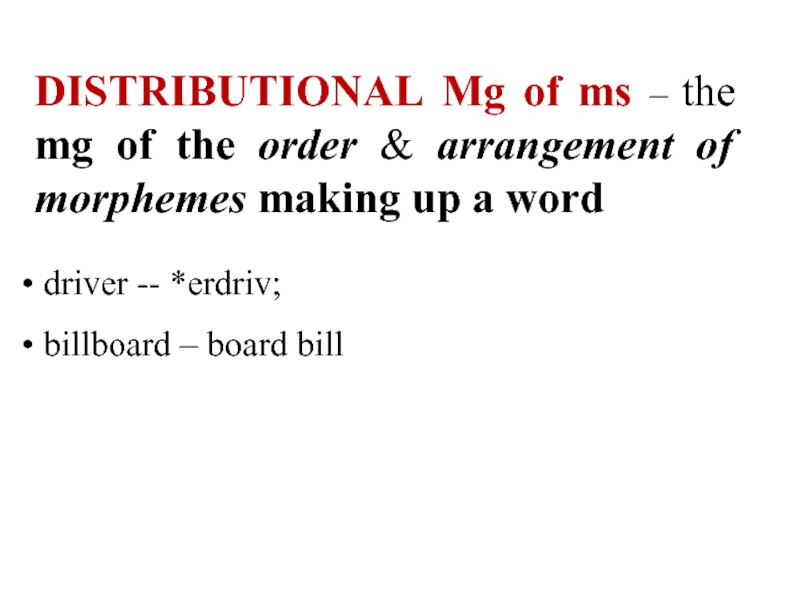
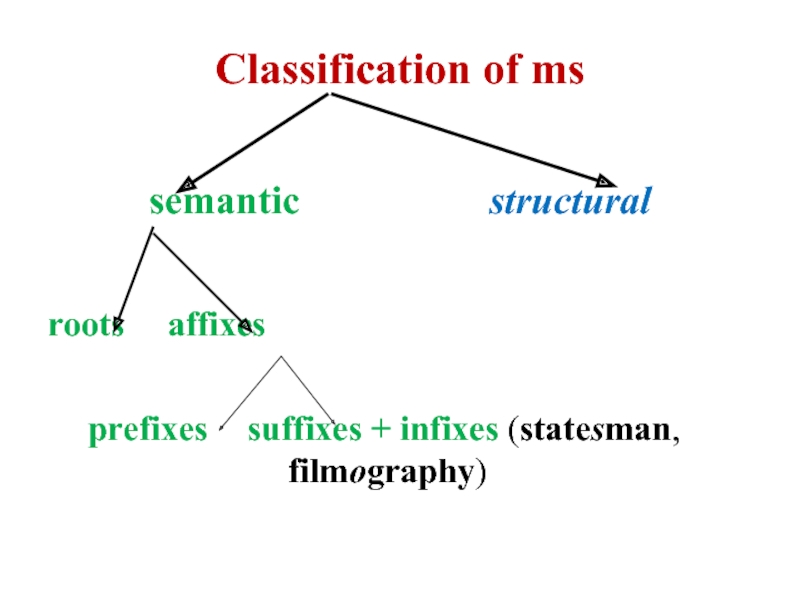
![Classification of ms structural free bound semi-free/semi-bound[run], [play] [-hood], [un-], [re-] [well] in](/img/tmb/1/49428/f3fc7f3c1d4a2e2ce097f149ce9617dd-800x.jpg)
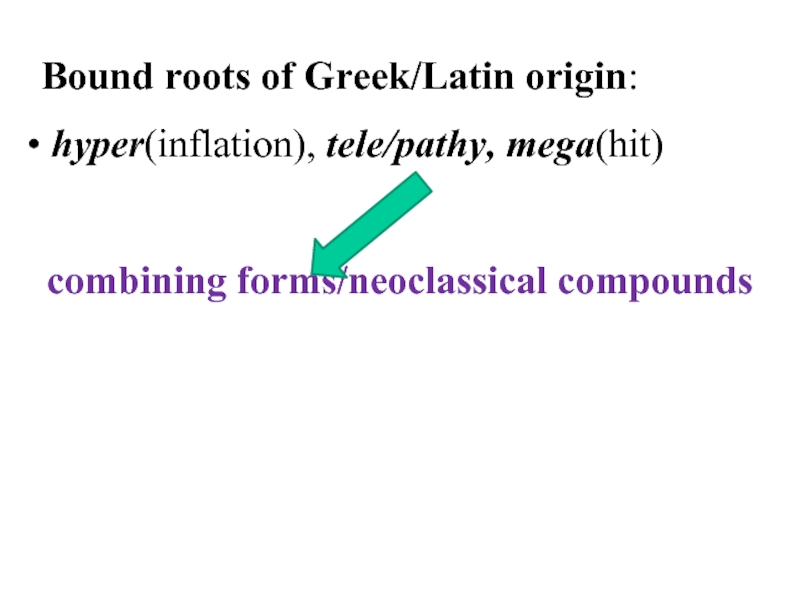
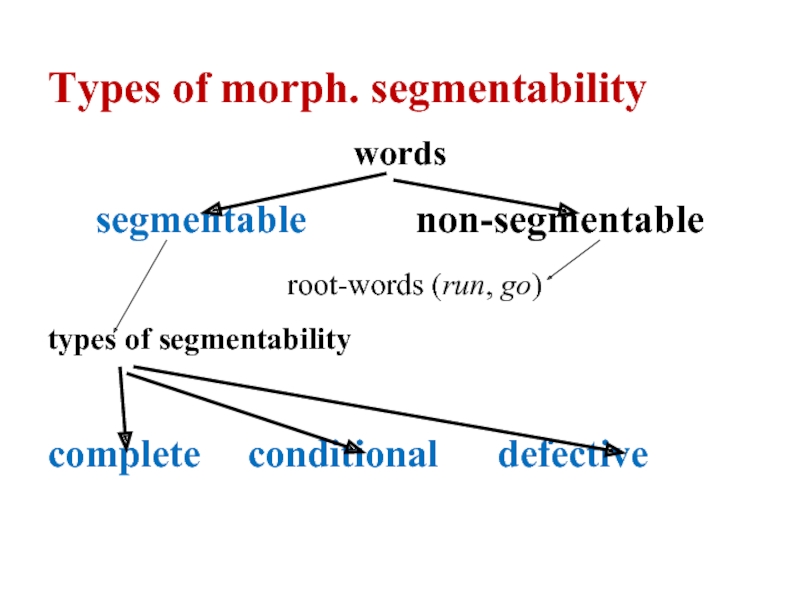
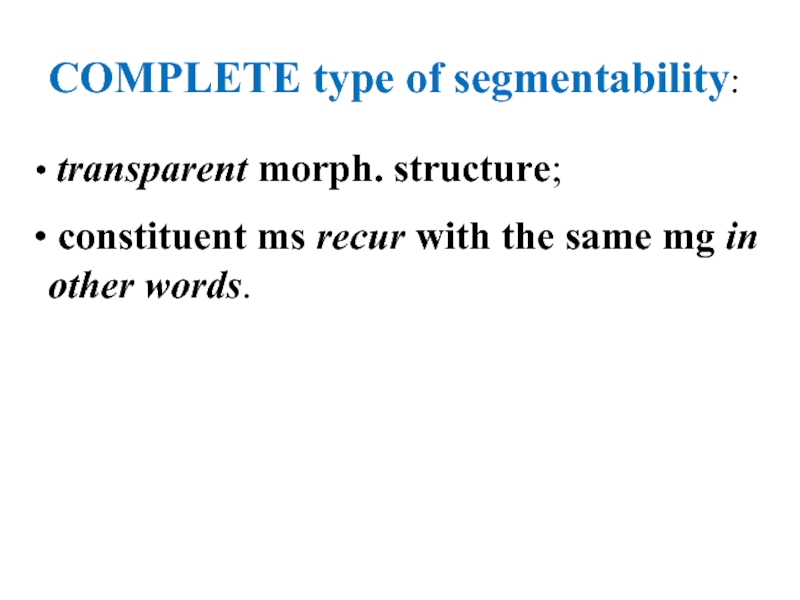
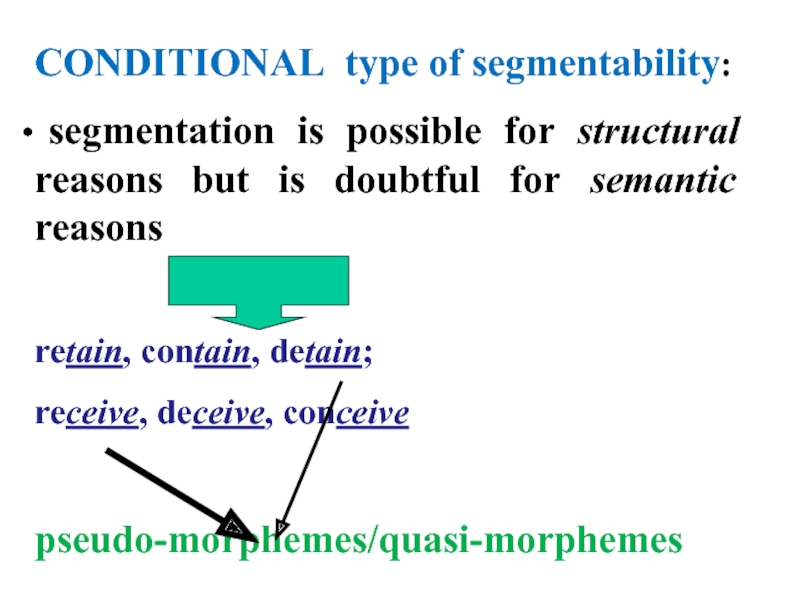
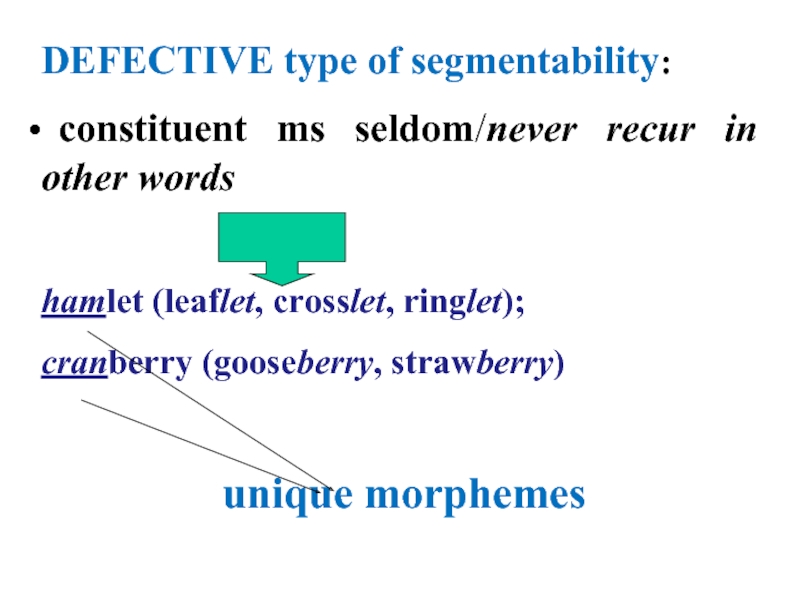
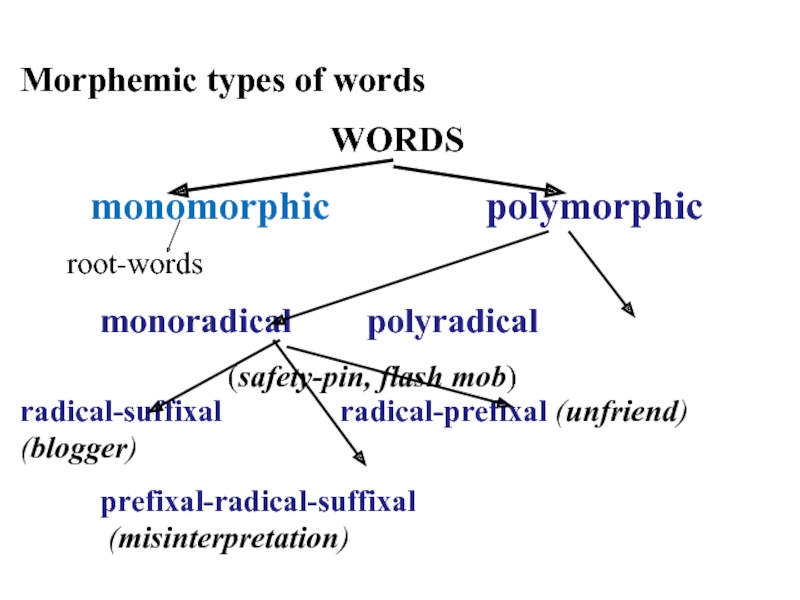
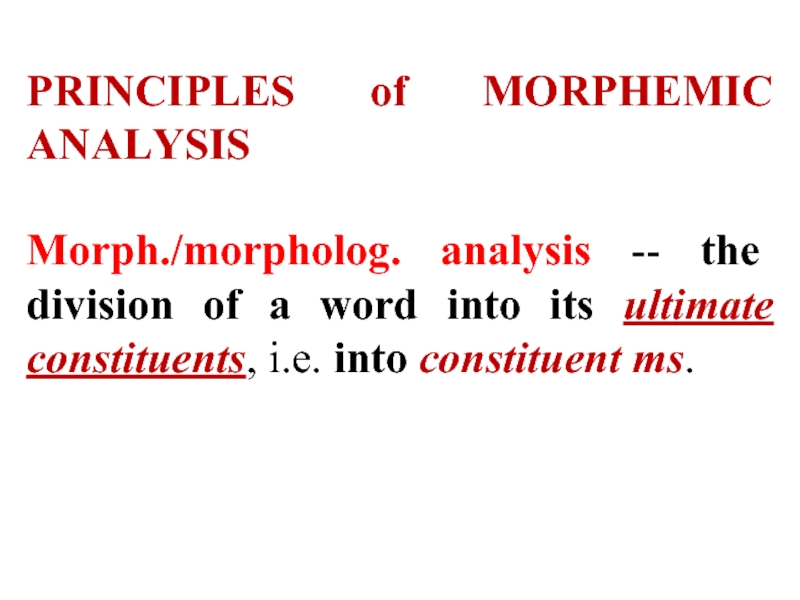
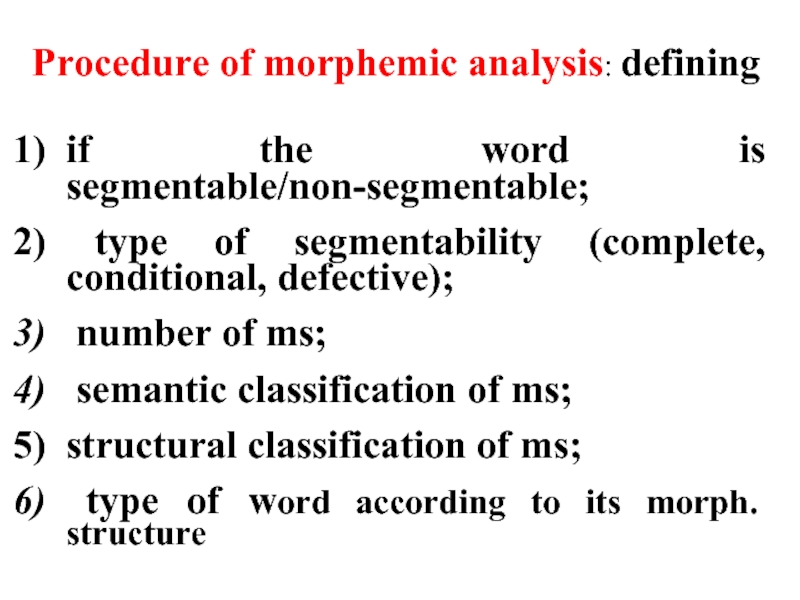
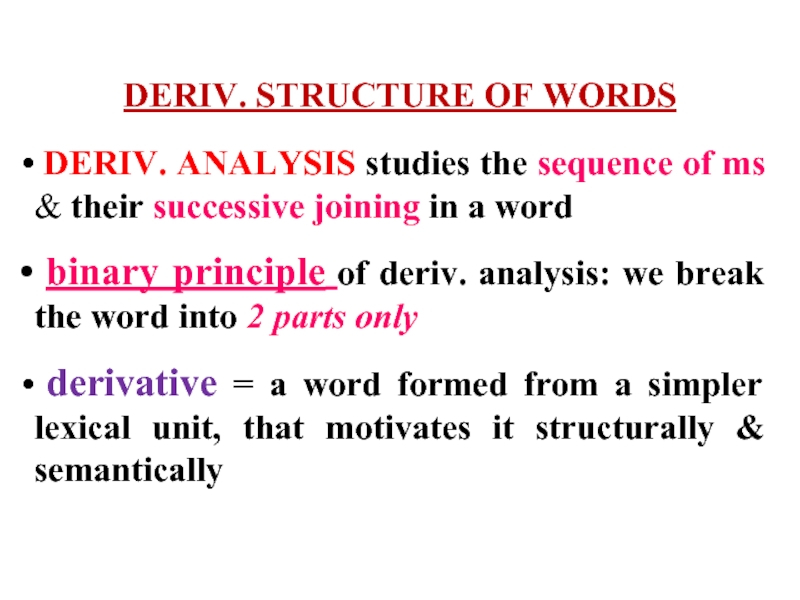
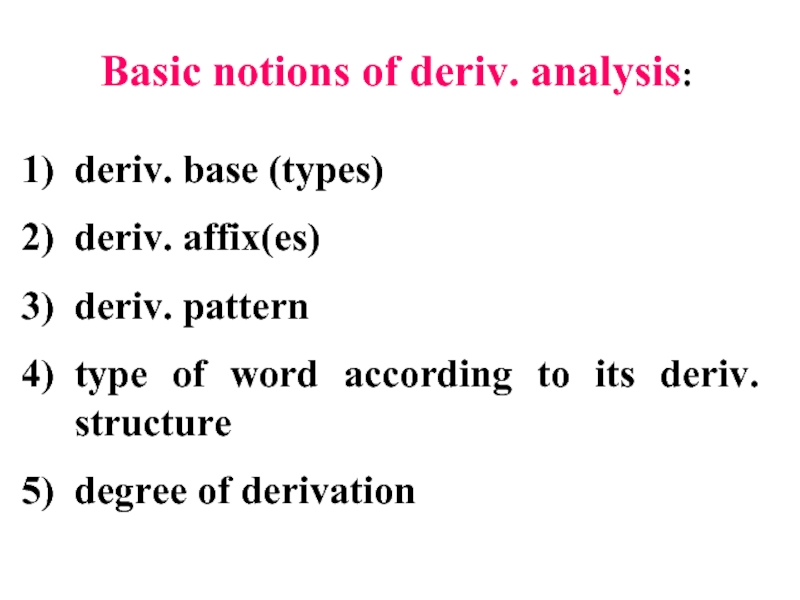
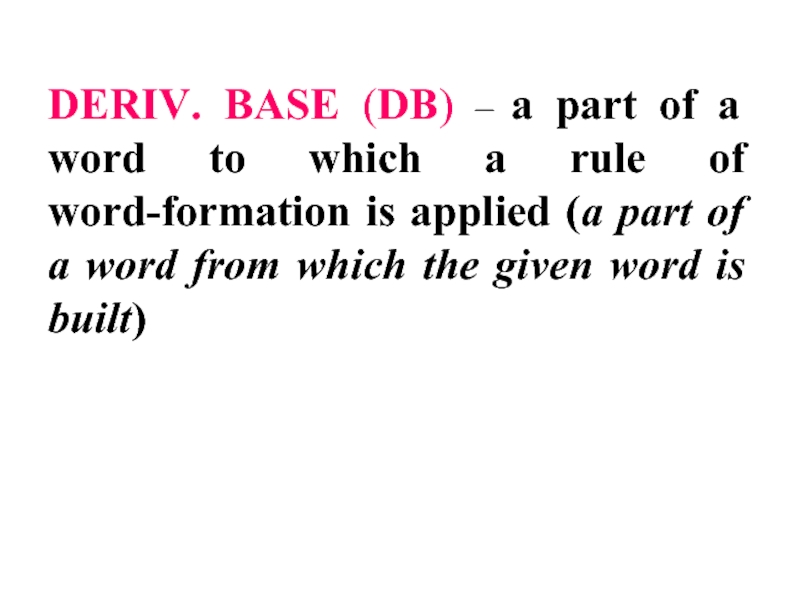
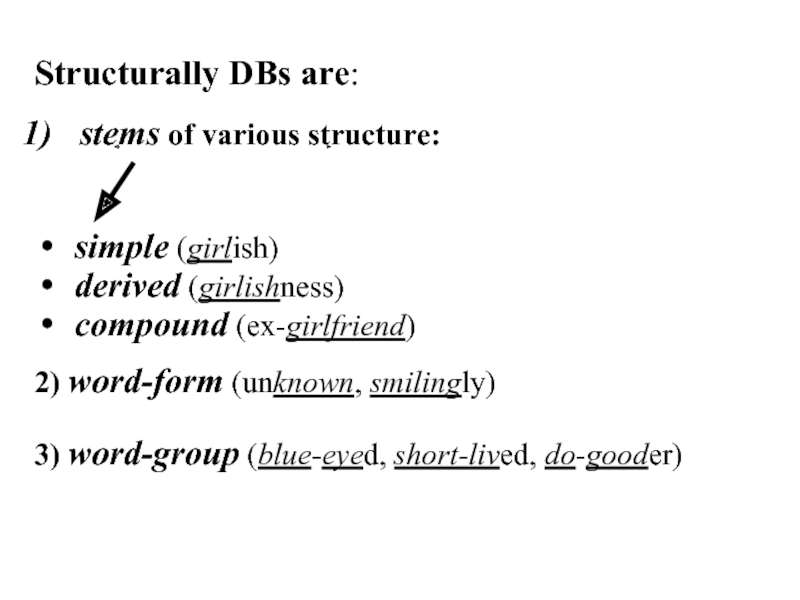
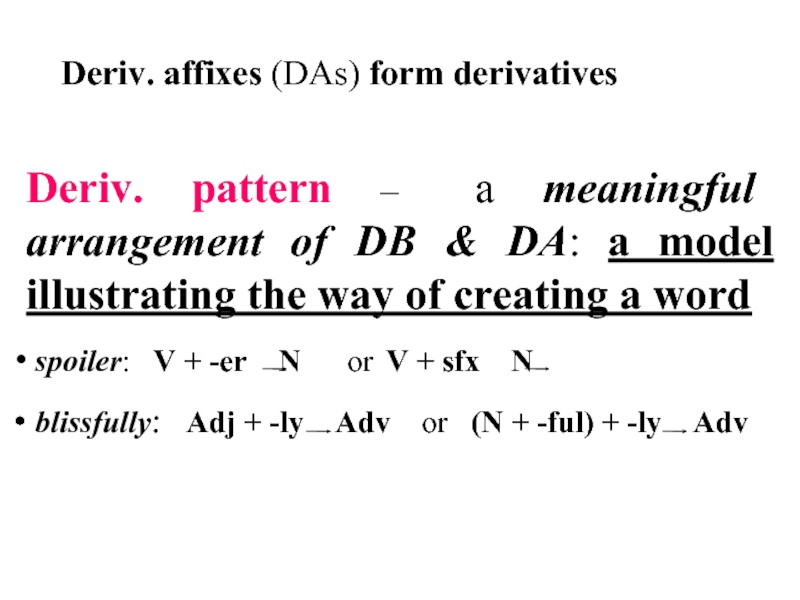
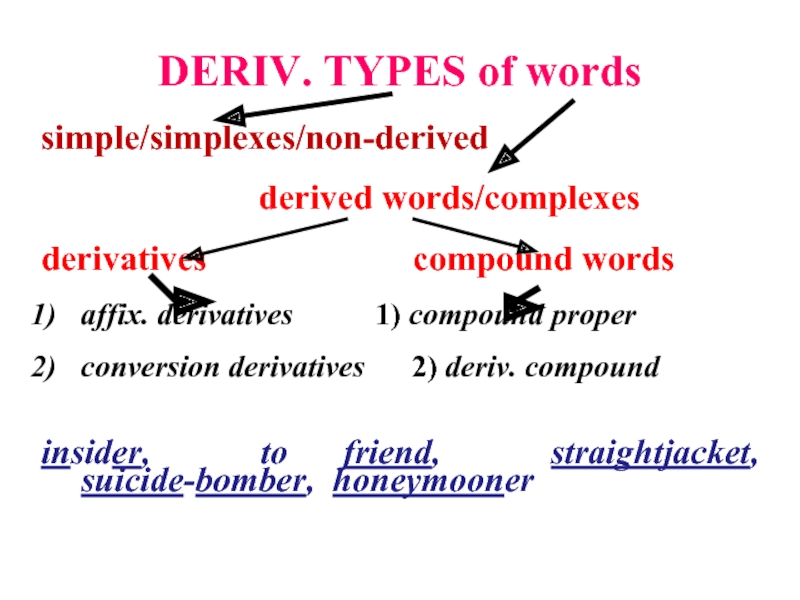
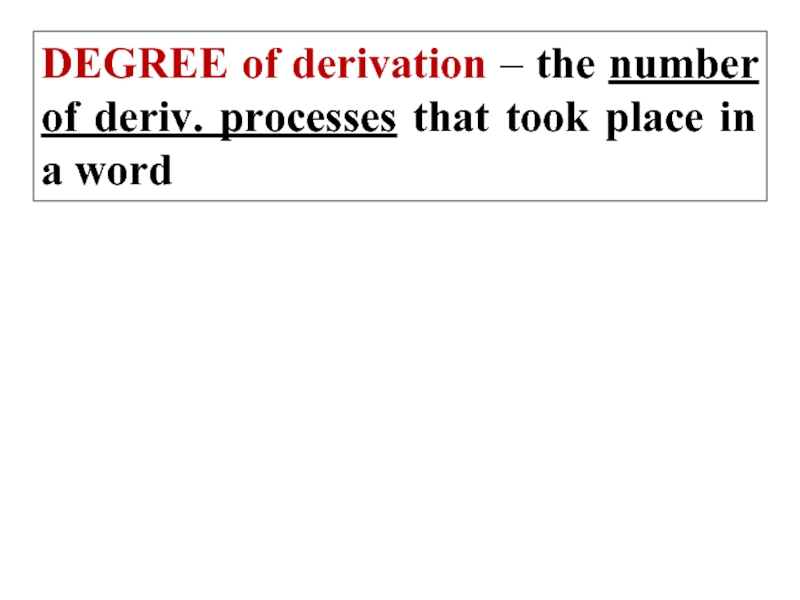
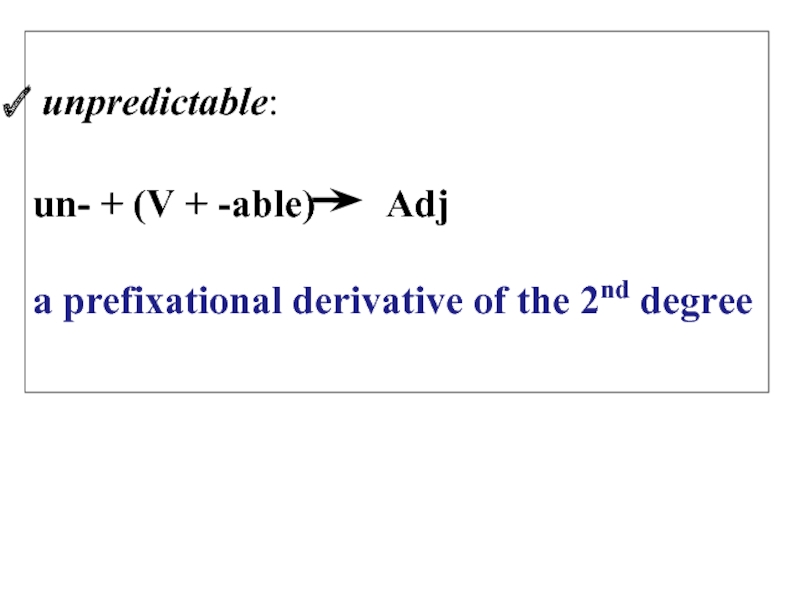
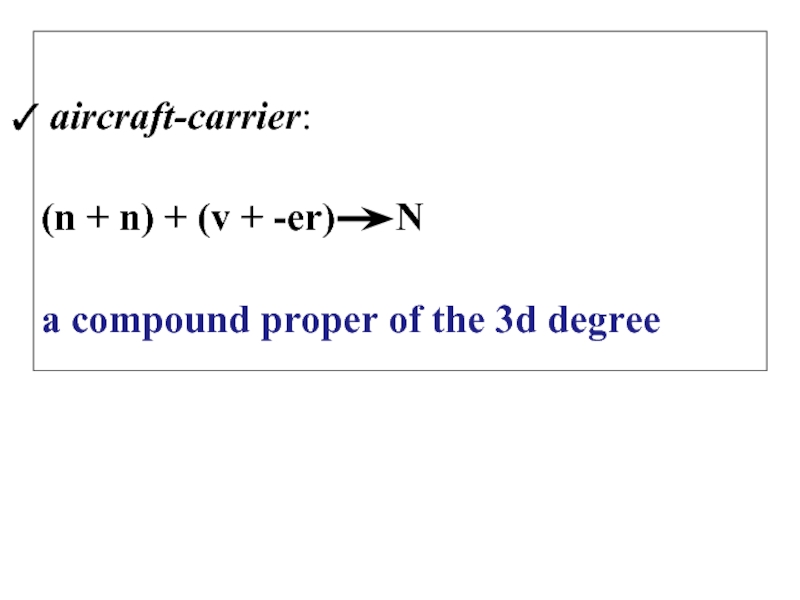
![denationalization: {de- + [(n + -al) + -ize]} + -tion N a suffixational](/img/tmb/1/49428/12095275183667cee1a5829e31ca2cc3-800x.jpg)


